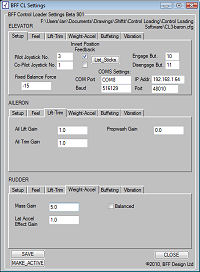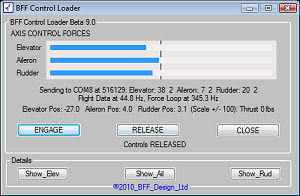Experimental Control Loader (Force
Feedback) Software
IMPORTANT
Sept 2011 - this version of the software and system has now
been superseded by a brushless motor system - See the new
DIY FFB Flight Yoke.
IMPORTANT - This software DOES NOT drive
of-the-shelf force feedback joysticks. It is intended for
DIY builders wishing to EXPERIMENT with their own higher
force flight control loader designs.
Following a number of requests from site
visitors I've made available the flight sim control loader
(force feedback) software developed during the various
force feedback projects described on the site. The software
calculates and exports force feedback levels used
to drive electric motor loaded DIY flight controls.
The software is experimental and I've made it
available for free (for personal non-commercial use).
The software is capable of providing 8, 10 or 16
bit force demands at up to 500Hz refresh rates. It works for MS FS9/X
systems. It can be run on the same PC as the flight sim
software or on a LAN PC if the CPU loading on the flight sim
PC is too high to allow the high force loop refresh rates
needed.
To operate effectively the software must be
used in an overall system as described below. Even then the
quality of the force feedback you obtain will be critically
dependent on the quality of the electric motors you use and
the quality of the design and build of the force
transmission and other mechanical elements in your controls.
To
generate actual motor torques the output from the software
must be externally processed and passed to motor speed
controllers which drive the motors. For builders who wish to
experiment with their own flight control designs but who do
not have expertise in building the required microcontroller based
hardware the 64SPU-1 micro-controller card available on the
site can be used - see above right. The 64SPU-1 card is
available un-programmed ready for programming with sample
flash programs I can provide or with your own PICAXE .bas
code.
If you require the sample control loader
PICAXE 20X2 flash programming for the 64SPU-1 card please
email me.
Making an effective control loading system is
a fascinating project, but it can be a fairly unforgiving task - so if you do try
it go into your project with your eyes (and your wallet)
open!
System
Click on the image below for a
system layout diagram. There are a set of
NOTES which should be read in conjunction with the layout
diagram. Please examine the layout diagram very carefully
and read ALL of the
notes as they are important. The system illustrated in
the diagram uses Devantech MD03 8 bit motor controllers to
drive DC motors - these could be changed for other
controllers if you have or can develop suitable
microcontroller programming to instruct them.
The 64SPU-1 card shown in the system could also be replaced
with your own signal processing hardware - the data output
formats of the control loader software are given in the
Quick Start Guide.

The system requires the flight controls to be
built using a 12 bit joystick card with precision
pots. This is because the control loader software taps
directly into the resulting joystick 12 bit position
reporting through the windows operating system - it does not
use dedicated stick position reporting pots/encoders. The
reporting MUST be 12 bit with maximum pot electrical travel
utilisation. I have used
Leo Bodnar's BU083A 12 bit card.
Software
The BFF Control Loader software has two main
programs - the BFF CL Setup application and the main
BFF Control Loader application.
 BFF
CL Setup is used to configure and save the control
loading parameters for individual aircraft or other flight
conditions. The settings are saved in .cfg configuration
files which can be selected when the main BFF
Control Loader software is run.
BFF
CL Setup is used to configure and save the control
loading parameters for individual aircraft or other flight
conditions. The settings are saved in .cfg configuration
files which can be selected when the main BFF
Control Loader software is run.
The setup program can also be used to adjust
individual settings whilst the control loader software is
active - this allows adjustments to be made and the effects
on the force levels and feel to be determined quickly. CARE
is needed when using this feature
I have not written an extensive user manual
for this experimental software. However there are fairly
detailed tool-tips available - move the mouse over any of
the Elevator axis input fields for details. The inputs for
the Aileron and Rudder axes have the same definitions as
those for the Elevator axis.

The main BFF Control Loader
application provides the live force level output. It can be run on the
flight sim PC or on a LAN PC. It pulls live flight data from
FS9/X using Pete Dowson's FSUIPC. It also pulls 12 bit
flight control position data from the windows joystick
interface and combines the two to calculate the force
feedback levels. The flight data and joystick movement/force
calculations are done through two separate processes so as
to maintain the high force loop refresh rates needed for
stable operation of the system.
The main force elements of the loading are -
-
Control and trim surface aerodynamic
loads
-
Control surface prop wash effects
-
Control surface weight and acceleration
loads
-
Buffeting effects from stall and landing
gear
-
Engine vibration effects
-
Fixed balance loads
-
Damping, friction and motor back-EMF
compensation forces (all position reporting quality
dependent).
Each of these is adjustable and can be
removed from the loading completely if required.
The loading model uses the control axis
position and velocity as the indicator of control surface
position and velocity. Airspeed, aircraft accelerations,
engine condition, gear position and stall state are all
taken from FS9/X. Trim surface position is taken from the
independent trim pot positions. Aerodynamic loads are
calculated from control surface deflection and airspeed. For
more information see the pop-up tool tips in the BFF CL
Setup application.
IMPORTANT - I've put the speed of movement
related terms into the software to allow them to be
experimented with. How effective these terms can be will
depend strongly on the quality of the control movement
reporting, the system refresh speeds and the quality of the
motors and transmissions - ie on the rest of the system
design. Remember the software is just one element of an
effective control loading system - the entire system MUST be
right to get good results.
I've put together a quick start guide to
assist with initial setup and use of the software.
BFF Control Loader Quick Start Guide
The guide includes details of the serial data
output formats used by the software to export the force
demands to allow you to program your own processing hardware
should you wish.
If you experiment with the software let me
know how you get on.
© This site is
copyrighted, If you'd like more information or have any
comments please contact me at